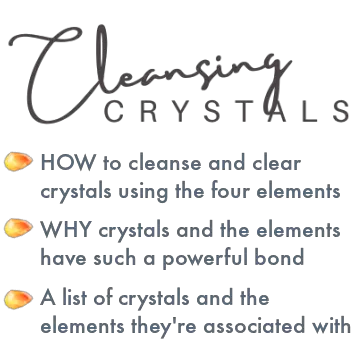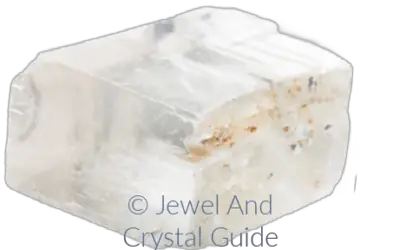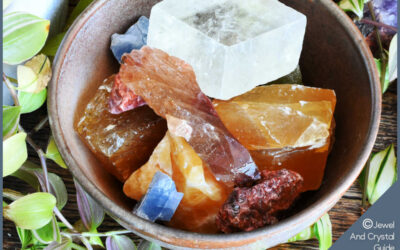Sometimes you just need to know if a piece of amazonite is authentic or fake.
You can tell if amazonite is real when it is green or bluish-green, bubbles in vinegar, is opaque to semi-translucent (can let a little light through), scratches glass, and sinks in water. These are all tests you can do at home, but a certified lapidist or jeweler can confirm your findings.
In this blog post, I’ll share all the things you can do to see if an amazonite crystal is real or not. While no test is foolproof, trying several of these methods should give you a good idea if you’re holding real amazonite or not.
By the end of this post, you’ll have 10 ways to tell if amazonite is real or fake.
Test if amazonite is real with …
A visual inspection
If you have the amazonite, look for clues to tell if it’s a real crystal or not.
Choose a place with good lighting, such as near a window during the day or under a bright lamp. The light helps you see the stone’s details more clearly.
Pick up the amazonite and look at it closely.
Real amazonite is microcline, a mineral that forms rocks. Microcline comes in many colors, but only green or blue-green microcline is called amazonite. The color should remind you of a tropical sea. If it isn’t all or mostly green, it isn’t amazonite.
You can find out more about what makes amazonite green in this blog post.

Amazonite often has interesting patterns and markings on it, and the bigger the piece the more markings you’ll notice. A lot of amazonite has white parallel streaks of the mineral albite running through it.
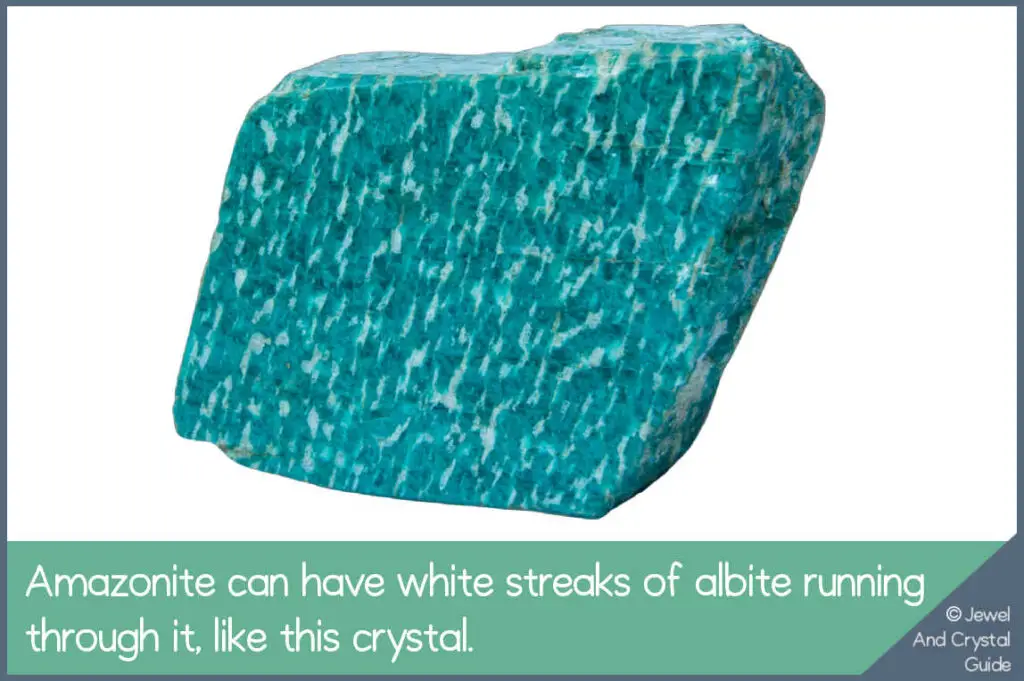
Sometimes there’s another or several colors of streaks or spots in an amazonite crystal. These secondary colors might be purple, pink, yellow, brown, gray, or black, or even a mix of these colors, and they’re all an indicator that the stone could be authentic.
Colorful streaks, veins, and markings on real amazonite are irregular and don’t form a noticeable pattern.
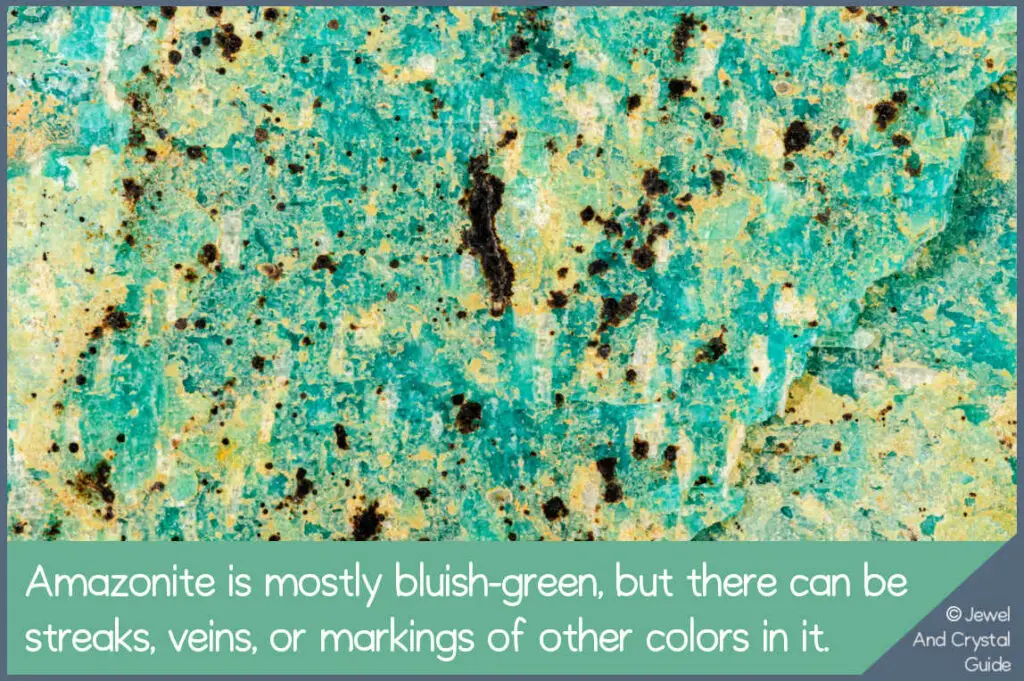
Notice how your crystal reflects light. When polished, real amazonite usually has a shiny appearance with a glassy or waxy surface. Look for a subtle sheen or glow on the crystal’s surface.
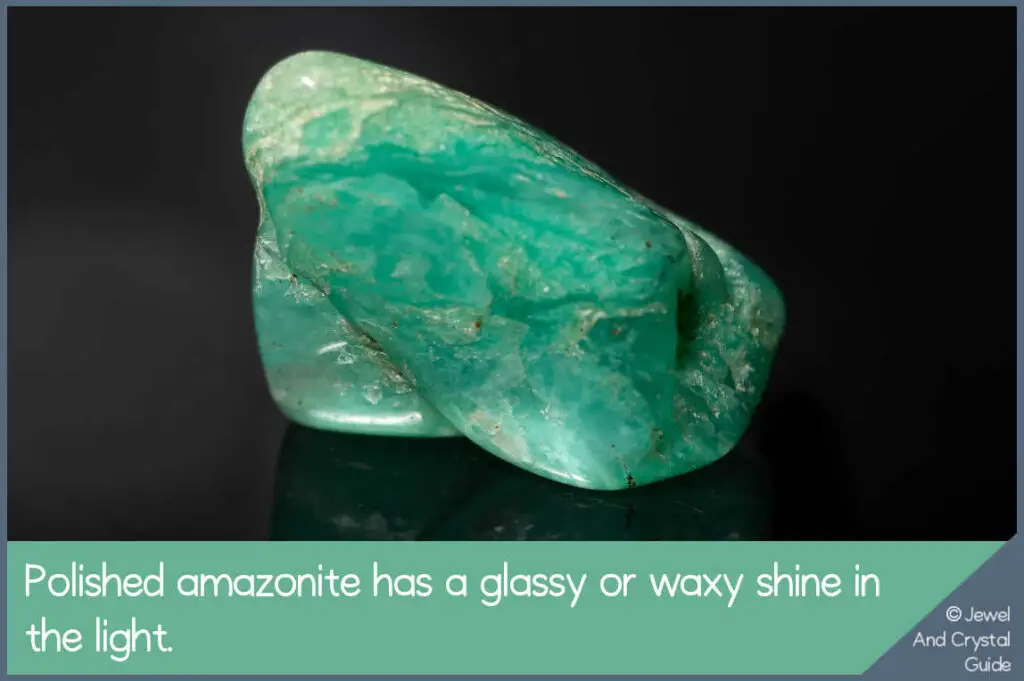
Shine a flashlight against the crystal or hold it up to the light to check if you can see light shining through it or not. Amazonite is typically opaque to semi-translucent, so it lets no light or a little light through to create a bit of a glow. It’s never completely see-through or completely translucent.
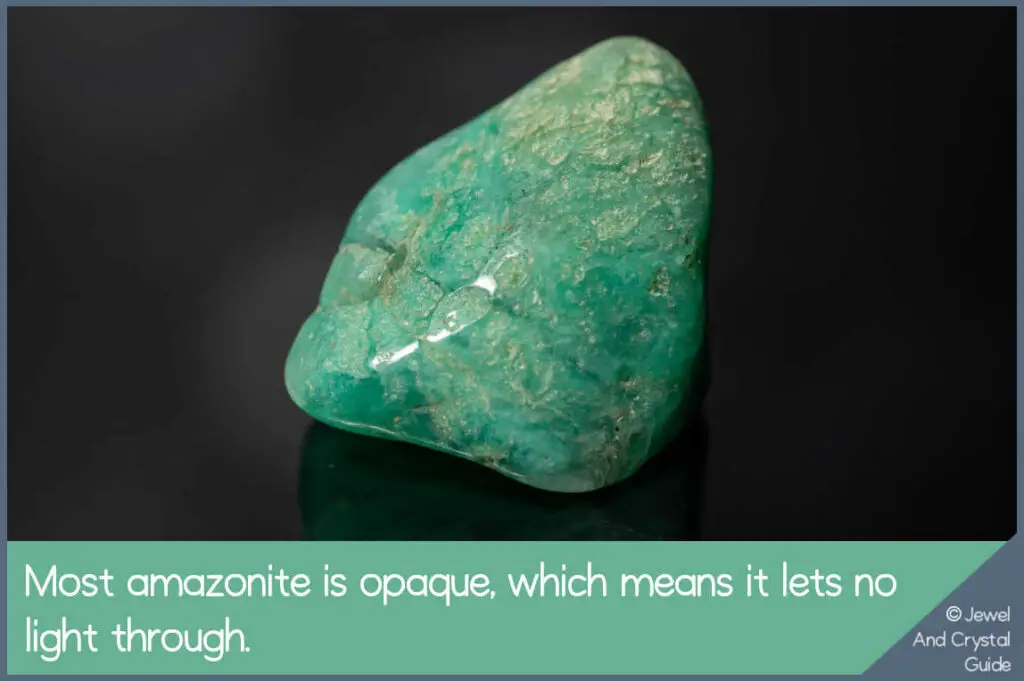
Some fake amazonite is glass or a crystal that’s worth less than real amazonite, and these could be more translucent than real amazonite. Take a close look at amazonite crystals every chance you get and you’ll soon get a good idea of how genuine crystals play with light.
Compare your amazonite to photos of real amazonite. Remember that crystals are made by nature, so each piece is unique and you’ll need to look at several pictures to see if your crystal reminds you of any of them. See if the colors, patterns, translucency, and overall appearance look similar.
Comparison can give you a better idea if your amazonite crystal is real or not.
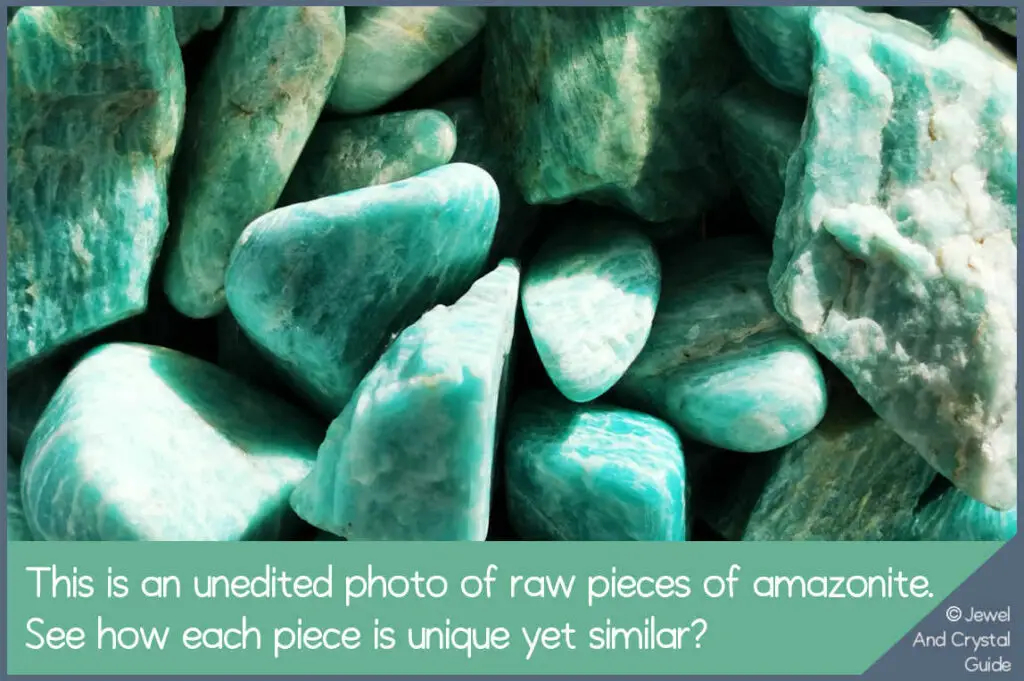
Get a full overview of amazonite crystals and links to my other relevant articles in this guide.
A bowl of water
Amazonite has a specific gravity of 2.56 to 2.58 grams, depending on what minerals are in the crystal. Water’s specific gravity is 1. This means that amazonite is “heavier” than water so it should sink.
Here’s how to test if amazonite crystal is real with a bowl of water:
Fill a container with enough water to fully submerge the crystal you want to test.
Gently lower the amazonite into the water, making sure it’s completely covered with water.
Now watch what happens.
If the crystal sinks and settles at the bottom of the container, it has a density higher than water and could be real amazonite.
If the crystal floats or stays near the surface of the water, it has a lower density than real amazonite or a density closer to water. This could mean it isn’t real amazonite and is more likely to be another crystal or even glass.
A scale and a calculator
In the previous method we learned that amazonite has a specific gravity of 2.56 to 2.58 grams, depending on what’s in the crystal, and water’s specific gravity is 1.
We can actually measure the specific gravity of the crystal for a more accurate result. Don’t be scared – I’ll show you how…
To get an object’s specific gravity, we measure how much space it takes when we drop it in water.
Here are the steps to calculate the specific gravity of a piece of amazonite:
- Weigh a container and write down the weight up to two decimal places. Make sure the container is large enough to hold water and the amazonite you are testing.
- Add water to the container and take this measurement, again with two decimal places.
- Put the amazonite in the water. Now write down this measurement up to two decimal places.
- Subtract the weight of the empty container from the weight of the water-filled container and the water and amazonite weight. You now have the true weights of the water and the water and amazonite together.
- Divide the true weight of the amazonite and water weight by the true weight of the water-only weight. This gives you the amazonite’s specific gravity.
If the specific gravity of the amazonite is around 2.56 to 2.58 grams, it falls within the typical range for amazonite and there’s a good chance the crystal is real.
If the specific gravity is significantly out of this range, there might be impurities in the amazonite or it might be imitation glass (which has a specific gravity of around 2.5 grams) or another crystal.
Remember that it’s a good idea to use different methods from this blog post to decide if a piece is natural amazonite or not. These tests are designed to give you a good idea whether the crystal is real or not, so the more you do the better your results will be.
A UV light test
Use a UV light to get more clues on whether or not your amazonite is real or something else:
1. Get a UV black light from Amazon or a local hardware store.
2. Wait for nightfall, then turn off the lights in a room to make it as dark as possible.
3. Hold the amazonite in your hand or put it on a clean, white surface. Shine the UV light onto the crystal from a few inches away.
4. See if the crystal glows under the UV light.
Some real amazonite glows a dark olive or yellowish green under the long-wave UV light from a black light.
If the amazonite has different colors in it from different minerals, you might notice these colors glowing different colors or not at all because different minerals glow in different ways under UV light.
But amazonite has weak fluorescence and isn’t well-known for glowing under UV light, so this test isn’t a guarantee that the crystal is real or fake – it’s just another clue in the puzzle.
A scratch test
The Mohs scale measures how hard minerals are. This scale runs from 1 to 10, with 1 being the softest (e.g. talc and chocolate) and 10 being the hardest (e.g. diamonds).
Items on the Mohs scale are ranked above all the things that are softer than them and below all the things that are harder than them.
Amazonite is a 6 on the Mohs scale, which makes it softer than minerals like citrine and rose quartz, but harder than minerals like glass, calcite and copper. Amazonite can scratch and mark things that are softer than it.
Scratch a piece of glass with the amazonite crystal. If the crystal leaves any sort of scratch or mark on the glass, even if you need to see it with a magnifying glass, there’s a good chance it’s real crystal.
This test can give you clues both ways:
Use the glass to scratch an inconspicuous part of the crystal. If the glass leaves a mark, then it can’t be real amazonite as real amazonite is harder than glass. If the glass doesn’t leave any mark, then there’s a good chance the crystal is real amazonite, or at least a crystal that’s harder than glass.
An acid test
Amazonite shows no reaction to acid because it doesn’t contain carbonate minerals. You can use a simple acid test at home to tell if the crystal is amazonite or another crystal that looks like amazonite, such as green calcite.
Take a steel knife and make a small scratch in a green or bluish-green area of the crystal. Try to create some powder shavings with the knife, and leave the shavings there on the crystal where you make them.
Gently drip a drop of vinegar onto the scratched area and look for bubbles – they might be difficult to see, so keep a close eye on the area.
If you see bubbles, you know the crystal isn’t amazonite. You more likely have calcite or aragonite in your hands. If there are no bubbles, you have another sign that the crystal could be amazonite.
A measure of how light bends
The refractive index measures how much light bends or changes direction when it passes through something. The higher the refractive index of a material, the more light bends, and the lower the refractive index of a material, the less light bends.
Amazonite has a refractive index of about 1.522 to 1.530.
To accurately measure a crystal’s refractive index and decide which crystal you have, you need to use a gem refractometer, like this one from Amazon.
Follow the instructions for your refractometer. If your refractive index reading is between 1.52 and 1.53, then there’s a chance your crystal is real amazonite.
If you don’t want to buy a refractometer, contact your local lapidary group or ask a qualified jeweler to take a look for you with their equipment.
A market comparison
Amazonite is not a very valuable crystal so there aren’t many fakes on the market. But some sellers try to sell imitation glass crystal or cheaper gemstones as real amazonite to make more money.
The cost of real amazonite depends on the quality, color, and size of the piece, as well as how many people want to buy it and how much amazonite is available.
Amazonite with several minerals and colors in it is usually cheaper than pure green amazonite.
Here is a table with the average price ranges of amazonite per carat:
| Quality | Price Range (USD) |
| Low-grade amazonite | $1 – $2 per carat |
| Medium-grade amazonite | $2 – $10 per carat |
| High-grade amazonite | $10 – $200 per carat |
A trustworthy seller
If you buy amazonite from a seller you know you can trust, and that seller tells you the amazonite is real, then it should be. If you aren’t sure and you must know, do your own tests or ask the seller outright.
Some things you can do to make sure the seller can be trusted is:
- Do some research on the seller to look for bad reviews or complaints that other people have made. You can also speak to others or join Facebook groups and ask for recommendations.
- Check the seller’s website to see what information they give and if they look authentic.
- Ask the seller to provide proof on where they got the amazonite from.
- Buy amazonite jewelry that is certified by the Gemological Institute of America (GIA) or the gem certification body in your country.
Confirmation by a professional
If you must know if a specimen is real amazonite or not, and none of the above methods have given you the answer, then ask a professional dealer, lapidist, or appraiser to take a look at the amazonite.
A professional has the tools, knowledge, and experience to give you a better idea if a piece of amazonite is real or not.






